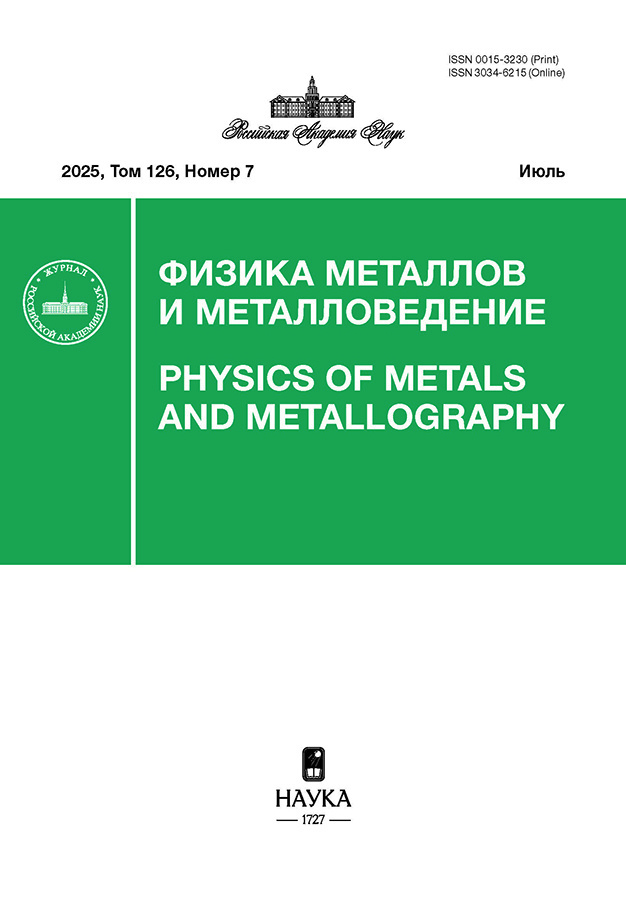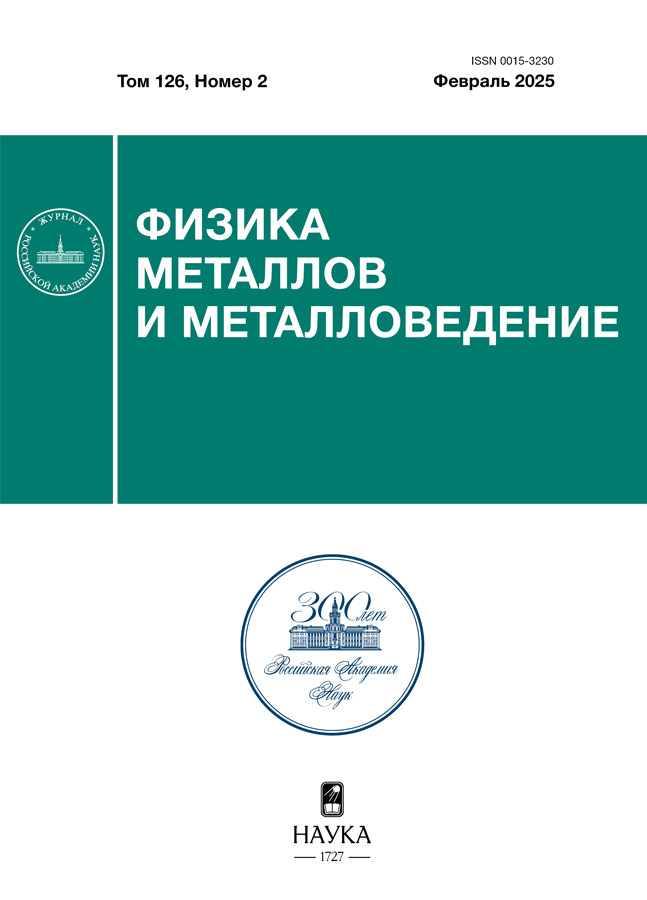Dynamic mechanism of lateral growth of thin-lamellar martensite crystals in iron-nickel alloys under external tensile stress
- Authors: Kashchenko N.M.1,2, Kashchenko M.P.1,3, Chashchina V.G.1,3
-
Affiliations:
- Ural Federal University named after the First President of Russia B. N. Yeltsin
- Ufa University of Science and Technology
- Ural State Forestry Engineering University
- Issue: Vol 126, No 2 (2025)
- Pages: 203-209
- Section: СТРУКТУРА, ФАЗОВЫЕ ПРЕВРАЩЕНИЯ И ДИФФУЗИЯ
- URL: https://rjmseer.com/0015-3230/article/view/683435
- DOI: https://doi.org/10.31857/S0015323025020099
- EDN: https://elibrary.ru/AYVAZY
- ID: 683435
Cite item
Abstract
Within the framework of the dynamic theory of martensitic transformations, the possibility of cooperative growth of the faces of the resulting crystal is discussed using the example of the formation of a layer parallel to the habit plane. This growth is comparable to the lateral crystal growth typical of shape memory alloys, but not typical of α-martensite in iron alloys upon simple cooling. However, under conditions of external tensile stress, rapid lateral growth of thin-lamellar α-martensite crystals was observed. It is shown that the formation of a layer parallel to the habit plane is similar to the formation of the original crystal. The functions of the dislocation nucleation center (DNC*) for this layer are performed by a dislocation loop framing the habit plane with the Burgers vector b*, and b* is specified by the macroshift in the initial crystal. An example of a crystal with a habit close to (3 14 9) is considered. The results of calculation of the elastic field of the DNC* loop are presented using data on the elastic moduli of the Fe–31.5%Ni alloy at a temperature Ms = 239 K. In the approximation of longitudinal waves for a pair of relatively long-wave components in the control wave process, the practical coincidence of the layer habit with the initial habit is demonstrated. The value of b* has been estimated.
Full Text
About the authors
N. M. Kashchenko
Ural Federal University named after the First President of Russia B. N. Yeltsin; Ufa University of Science and Technology
Author for correspondence.
Email: nad.kashenko@yandex.ru
Russian Federation, Ekaterinburg; Ufa
M. P. Kashchenko
Ural Federal University named after the First President of Russia B. N. Yeltsin; Ural State Forestry Engineering University
Email: nad.kashenko@yandex.ru
Russian Federation, Ekaterinburg; Ekaterinburg
V. G. Chashchina
Ural Federal University named after the First President of Russia B. N. Yeltsin; Ural State Forestry Engineering University
Email: nad.kashenko@yandex.ru
Russian Federation, Ekaterinburg; Ekaterinburg
References
- Курдюмов Г.В., Утевский Л.М., Энтин Р.И. Превращения в железе и стали. М.: Наука, 1977. 238 с.
- Счастливцев В.М., Калетина Ю.В., Фокина Е.А. Мартенситное превращение в магнитном поле. Екатеринбург: УрО РАН, 2007. 322 с.
- Кащенко М.П., Кащенко Н.М., Чащина В.Г. Вырожденная структура двойников превращения и монокристалличность части тонкопластинчатого мартенсита, инициированного сильным магнитным полем // Изв. РАН. Механика твердого тела. 2020. № 1. С. 9–20.
- Пушин В.Г., Кондратьев В.В., Хачин В.Н. Предпереходные явления и мартенситные превращения. Екатеринбург: УрО РАН, 1998. 368 с.
- Shibata A., Murakami T., Morito Sh., Furuhara T., and Maki T. The Origin of Midrib in Lenticular Martensite // Mater. Trans. 2008. V. 8. № 6. P. 1242–1248.
- Кащенко М.П. Волновая модель роста мартенсита при g-a превращении в сплавах на основе железа. М. – Ижевск: НИЦ “Регулярная и хаотическая динамика”, ИИКТ, 2010. 280 с.
- Кащенко М.П., Чащина В.Г. Динамическая модель сверхзвукового роста мартенситных кристаллов // УФН. 2011. Т. 181. № 4. С. 345–364.
- Levitas V.I. Recent In Situ Experimental and Theoretical Advances in Severe Plastic Deformations, Strain-Induced Phase Transformations, and Microstructure Evolution under High Pressure // Mater. Trans. 2023. V. 64. No. 8. P. 1866–1878. https://doi.org/10.2320/matertrans.MT-MF2022055
- Pushin V.G., Kuranova N.N., Marchenkova E.B., and Pushin A.V. Deformation-Induced Atomic Disordering and bcc → fcc Transformation in Heusler Alloy Ni54Mn21Ga25 Subjected to Megaplastic Deformation by High Pressure Torsion // Phys. Met. Metal. 2020. V. 121. No. 4. P. 330–336.
- Tyc O., Iaparova E., Molnárová O., Heller L., Šittner P. Stress induced martensitic transformation in NiTi at elevated temperatures: Martensite variant microstructures, recoverable strains and plastic strains // Acta Mater. 2024. V. 279. P. 120287.
- Singh P., Picak S., Sharma A., Chumlyakov Y., Arróyave R., Karaman I., Johnson D.D. Martensitic Transformation in Fe{x}Mn{80-x}Co{10}Cr{10} High-Entropy Alloy // Physical Review Letters. 2021. V. 127. P. 115704. https://doi.org/10.1103/PhysRevLett.127.115704
- Кащенко М.П., Чащина В.Г. Описание морфологических признаков при В2 – В19 мартенситном превращении в рамках концепции управляющего волнового процесса // Физич. мезомеханика. 2014. Т. 17. № 4. С. 69–76.
- Greninger A.B., Troiano A.R. The mechanism of martensite formation // Metal. Trans. 1949. V. 185. P. 590–598.
- Haush G., Warlimont H. Single crystalline elastic constants of ferromagnetic centered cubic Fe–Ni invar alloys // Acta Met. 1973. V. 21. P. 400–414.
- Кащенко М.П., Теплякова Л.А., Джемилев К.Н., Чащина В.Г. Условия генерации кристонов и интерпретация кривой σ–ε для монокристаллов Ni3Fe // ФММ. 1999. Т. 88. № 3. С. 17–21.
- Kashchenko M.P., Teplyakova L.A., Chashchina V.G. Peierls Stress for [ll2h]{hhl) Shear in the FCC lattice // Phys. Met. Metal. 2000. V. 90. № 1. P. 21–26.
- Кащенко М.П., Кащенко Н.М., Чащина В.Г. Динамическая модель пространственного масштабирования начального возбужденного состояния при реконструктивных мартенситных превращениях // ФММ. 2021. Т. 122. № 9. С. 895–901.
Supplementary files
















